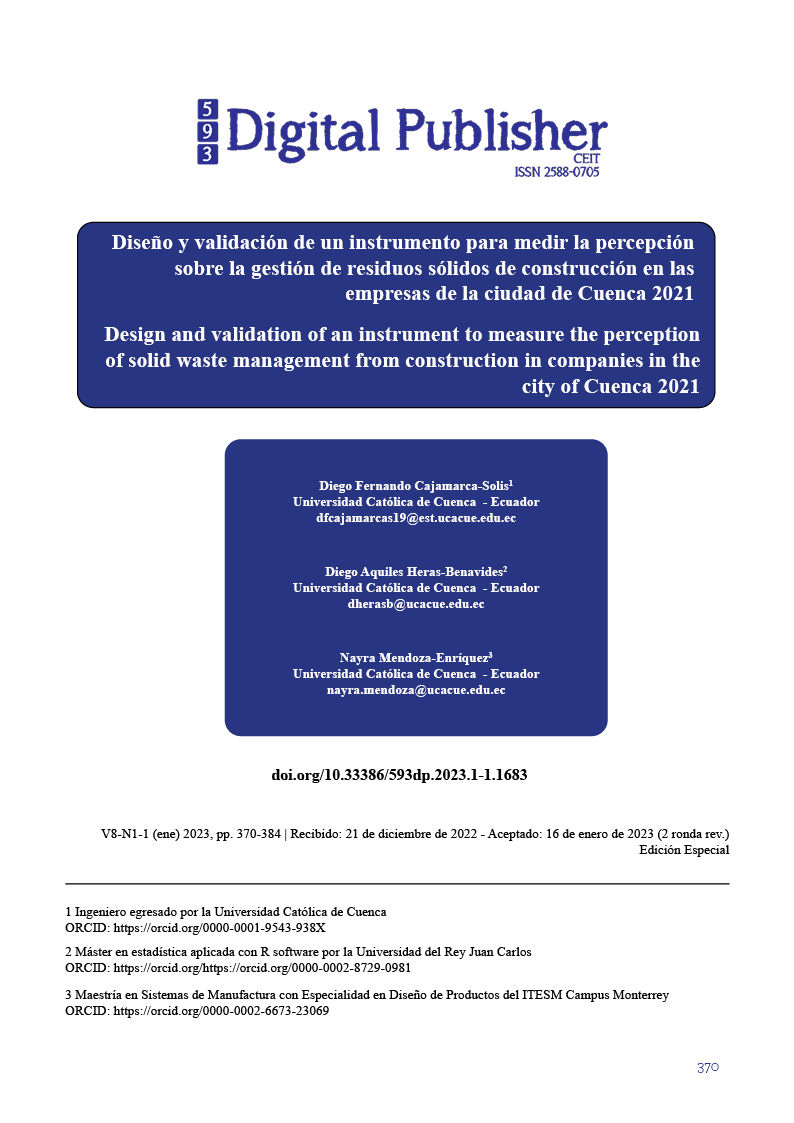Design and validation of an instrument to measure the perception of solid waste management from construction in companies in the city of Cuenca 2021.
Main Article Content
Abstract
Correct management of solid waste produced by different industries significantly reduces the impact on the environment and protects its. Regulatory and technological processes, and environmental policy, related to waste management have been poorly developed and implemented in construction projects. In Cuenca, although management processes are applied, there is no tool to assess the level of perception associated with solid waste management in construction companies in the city.
Objective: This research designed an instrument to measure the perception of solid waste management from construction in companies in the city of Cuenca.
Method: This study adopted a quantitative approach and relied on an observational design. A survey proposal was evaluated by a group of experts, and then applied to construction professionals. The data obtained were subjected to statistical validation using the JAMOVI and JASP software, thus achieving a validated scale.
Result: A final scale-type instrument was established, it was composed of ten items and distributed in three dimensions: the knowledge and identification of solid waste (CIRS), the construction waste management (GRC) and the effects of construction waste (ERC).
Conclusions: The scale allows to measure the waste management situation of a company with an acceptable level of reliability and validity. Processes of: optimization, decision making and continuous improvement will be derived from the information supplied by the instrument.
Downloads
Article Details

This work is licensed under a Creative Commons Attribution-NonCommercial-ShareAlike 4.0 International License.
1. Derechos de autor
Las obras que se publican en 593 Digital Publisher CEIT están sujetas a los siguientes términos:
1.1. 593 Digital Publisher CEIT, conserva los derechos patrimoniales (copyright) de las obras publicadas, favorece y permite la reutilización de las mismas bajo la licencia Licencia Creative Commons 4.0 de Reconocimiento-NoComercial-CompartirIgual 4.0, por lo cual se pueden copiar, usar, difundir, transmitir y exponer públicamente, siempre que:
1.1.a. Se cite la autoría y fuente original de su publicación (revista, editorial, URL).
1.1.b. No se usen para fines comerciales u onerosos.
1.1.c. Se mencione la existencia y especificaciones de esta licencia de uso.
References
Al-Rifai, J., & Amoudi, O. (2016). Understanding the key factors of construction waste in Jordan. Jordan Journal of Civil Engineering, 10(2), 244–253. https://doi.org/10.14525/JJCE.10.1.3540
Castaño, J., Rodriguez, R., Lasso, L., Cabrera, A., & Ocampo, M. (2013). Waste management from construction and demolition (RCD) in Bogota: prospects and limitations. Tecnura, 17(38), 121–129. http://www.scielo.org.co/pdf/tecn/v17n38/v17n38a10.pdf
Contreras, J., Arias, J., Martín, R., & Hidalgo, V. (2021). Cuestionario para la selección de conceptos fundamentales : análisis de validez y confiabilidad (Issue Cinaic, pp. 232–237). Universidad de Zaragoza. https://doi.org/10.26754/CINAIC.2021.0046
Galicia, L., Balderrama, J., & Navarro, R. (2017). Validez de contenido por juicio de expertos: propuesta de una herramienta virtual. Apertura, 9(2), 42–53. https://doi.org/10.32870/ap.v9n2.993
González, A., & Pazmiño, M. (2015). Cálculo e interpretación del Alfa de Cronbach para el caso de validación de la consistencia interna de un cuestionario, con dos posibles escalas tipo Likert. Revista Publicando, 2(2), 62–67.
Griffin, M. M., & Steinbrecher, T. D. (2013). Large-Scale Datasets in Special Education Research. International Review of Research in Developmental Disabilities, 45, 155–183. https://doi.org/10.1016/B978-0-12-407760-7.00004-9
Hernández, R., Fernández, C., & Baptista, P. (2014). Metodología de la Investigación (McGraw-Hill (ed.); 5th ed.).
Kibert, C. J. (2017). The next generation of sustainable construction. Building Research & Information, 3218(October), 595–601. https://doi.org/10.1080/09613210701467040
Magaña, D., Aguilar, N., & Vazquez, J. (2017). Análisis Factorial Confirmatorio para medir las limitantes percibidas en el pregrado en el desarrollo de actividades de investigación. Nova Scientia, 9(18), 515–536. https://doi.org/10.21640/ns.v9i18.838
Molinari, A., & Padilla, R. (2018). Algunos alcances y elementos de la responsabilidad civil contractural del constructor. especial -enfasis en el contrato de construcción bajo la modalidad Fast Track. Revista Chilena de Derecho Privado, 31, 279–317. https://doi.org/10.4067/s0718-80722018000200279
Morales, M., Flórez, M., Solano, S., Morgan, S., Schultz, M., & Córdoba, O. (2011). Guía de manejo de escombros y otros residuos de la construcción.
Morocho, T. (2015). GESTION DE LA CALIDAD EN LOS PROCESOS CONSTRUCTIVOS, SITUACION ACTUAL DE LA MANO DE OBRA CIVIL ECUATORIANA. CIENCIA, 17(1), 125–136. https://journal.espe.edu.ec/ojs/index.php/ciencia/article/view/515/423
Poon, C. S., Yu, A. T. W., Wong, S. W., & Cheung, E. (2004). Management of construction waste in public housing projects in HongKong. Construction Management and Economics, 22(7), 675–689. https://doi.org/10.1080/0144619042000213292
Pozo, J. M., Valdés, A., Aguado, P., Guerra, M., & Medina, C. (2011). Estado actual de la gestión de residuos de construcción y demolición : limitaciones. Informes de La Construcción, 63, 89–95. https://doi.org/10.3989/ic.09.038
Robayo, A., Mattey, E., Silva, Y., Burgos, D., & Arjona, S. (2015). Los residuos de la construcción y demolición en la ciudad de Cali: un análisis hacia su gestión, manejo y aprovechamiento. Tecnura, 19(44), 157–170. https://doi.org/http://doi.org/10.14483/udistrital.jour.tecnura.2015.2.a12
Sánchez Cotte, E., Pacheco Bustos, C. A., & Páez, C. (2020). Una visión de Ciudad sostenible desde el modelo de gestión de los residuos de construcción y demolición (Rcd) caso De estudio: Barranquilla. Tecnura, 24(63), 68–83. https://doi.org/10.14483/22487638.15359
Shen, L. Y., & Tam, V. W. Y. (2002). Implementation of environmental management in the Hong Kong construction industry. International Journal of Project Management, 20(7), 535–543. https://doi.org/10.1016/S0263-7863(01)00054-0
Shen, L. Y., Tam, V. W. Y., Tam, C. M., & Drew, D. (2004). Mapping Approach for Examining Waste Management on Construction Sites. Journal of Construction Engineering and Management, 130(4), 472–481. https://doi.org/10.1061/(asce)0733-9364(2004)130:4(472)
Soto, C. M., & Segovia, J. L. (2009). Intervalos de confianza asimétricos para el índice la validez de contenido: un programa Visual Basic para la V de Aiken. Anales de Psicología, 25(1), 169–171. https://doi.org/https://doi.org/10.6018/71631
Susunaga Monroy, J. M. (2014). Construcción Sostenible, Una Alternativa Para La Edificación De Viviendas De Interes Social Y Prioritario. Journal of Chemical Information and Modeling, 53(9), 1689–1699.
Yuan, K. (2010). Fit Indices Versus Test Statistics. Multivariate Behavioral, January 2015, 115–148. https://doi.org/10.1207/s15327906mbr4001
Zheng, C., & Lu, M. (2016). Optimized Reinforcement Detailing Design for Sustainable Construction: Slab Case Study. Procedia Engineering, 145, 1478–1485. https://doi.org/10.1016/j.proeng.2016.04.186




